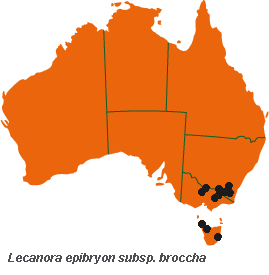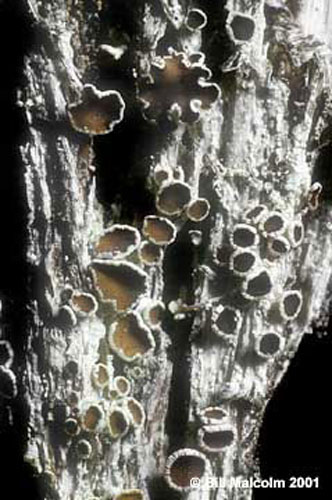



Australian Biological Resources Study
| Checklist of the Lichens of Australia and its Island Territories | ||
| Introduction | A–D | E–O | P–R | S–Z | Oceanic Islands | References | ||
| Lecanora epibryon (Ach.) Ach. subsp. broccha (Nyl.) Lumbsch | ||
| in H.T.Lumbsch, G.B.Feige & J.A.Elix, Pl. Syst. Evol. 191: 229 (1994); Lecanora broccha Nyl., in J.M.Crombie, J. Bot. 13: 21 (1875). T: “Kerguelens Land, Royal Sound”, Dec. 1875, A.E.Eaton; lecto: BM, fide H.T.Lumbsch et al., loc. cit.; isolecto: BM, H-NYL 25759. | ||
| Thallus thin, dispersed-verrucose to verruculose, yellowish white to yellowish orange, or whitish orange to cream-coloured, epruinose. Soredia absent. Prothallus not visible. Apothecia sessile to slightly constricted at the base, 0.8–2.5 mm diam.; disc pale to dark red-brown or almost black, epruinose; margin concolorous with the thallus, thin, entire, flexuose. Cortex hyaline, indistinct, gelatinous, inspersed with small crystals, 40–55 µm thick laterally and 55–120 µm thick basally. Amphithecium with small crystals that dissolve readily in KOH (allophana-type). Parathecium hyaline, 10–12 µm thick, with numerous small crystals soluble in KOH. Epihymenium reddish brown, c. 10–15 µm thick, K–, without crystals (glabrata-type), with small oil droplets. Hymenium hyaline, inspersed with small oil droplets, 55–80 µm thick. Hypothecium and subhymenium hyaline. Paraphyses c. 2 µm wide, sparingly branched apically; apices capitate, to c. 3.5 µm wide, reddish brown. Ascospores ellipsoidal, 12.5–17.5 × 6.5–9.5 µm. CHEMISTRY: Chemistry: Thallus and apothecial margin K+ yellow or K+ yellow → reddish, C+ faint orange to reddish, Pd+ yellowish orange; containing stictic acid (major), norstictic acid (submajor), atranorin (submajor), barbatic acid (submajor), 2,5,7-trichloro-3-O-methylnor-lichexanthone (submajor), chloroatranorin (minor), connorstictic acid (minor), constictic acid (minor), ±4-O-demethylbarbatic acid (minor), 5,7-dichloro-3-O-methylnorlichexanthone (minor), ±gyrophoric acid (minor), ±lecanoric acid (minor), ±3-O-methylasemone (minor), 2,5,7-trichlorolichexanthone (minor), ±ursolic acid (minor), ±methyl barbatate (trace), ±methyl-ß-orsellinate (trace), menegazziaic acid (trace) and cryptostictic acid (trace). |  |
|
| Occurs in N.S.W., A.C.T., Vic. and Tas. Outside Australia it is known from montane regions of southern South America (Patagonia, Tierra del Fuego), the Subantarctic (Kerguelen Is., Macquarie Is.), and mountains in New Guinea and New Zealand. | ||
 |
||
| Lumbsch & Elix (2004) | ||
| Checklist Index |
| Introduction | A–D | E–O | P–R | S–Z | Oceanic Islands | References |
This work is copyright. Apart from any use as permitted under the Copyright Act 1968, no part may be reproduced by any process without prior written permission from Australian Biological Resources Study. Requests and inquiries concerning reproduction and rights should be addressed in the first instance to Dr P. McCarthy. These pages may not be displayed on, or downloaded to, any other server without the express permission of ABRS.